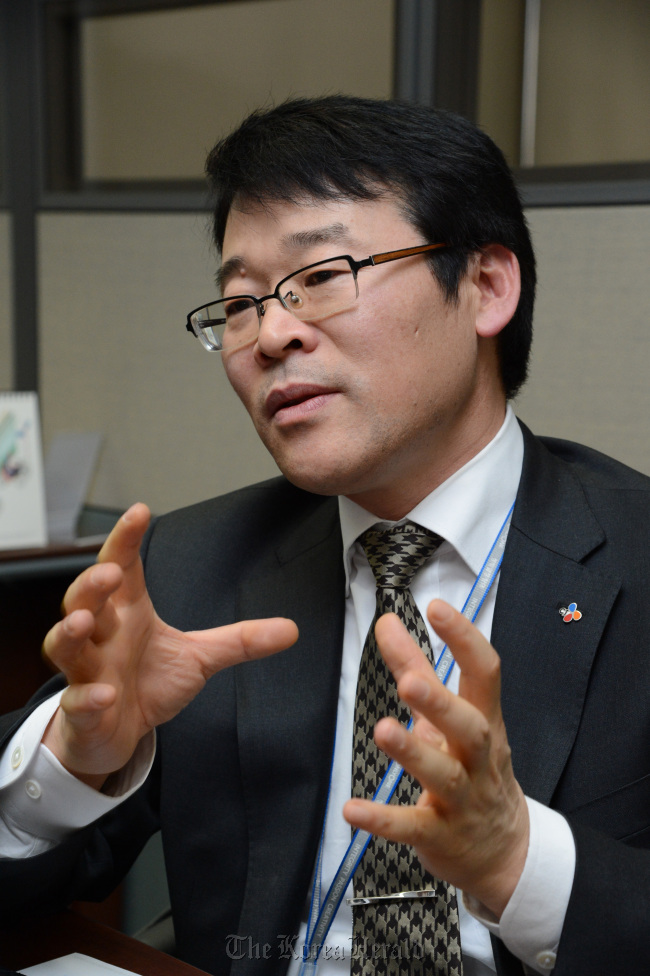 |
Interior of an Olive Young store |
In a few months, the first overseas store of Olive Young, Korea’s largest health and beauty store chain, will open near Shanghai’s Jiuguang Department Store, backed by a legion of CJ Group affiliates and riding on hallyu.
“With K-beauty, K-food and K-pop zones brandishing products promoted by hallyu stars, the Shanghai outlet will look similar to our two-story flagship store in Seoul’s Myeong-dong, only about half the size,” Kim Jin-gook, head of CJ Olive Young’s merchandise division, said in an interview with The Korea Herald.
“Our store site in Shanghai is surrounded by office buildings as our target is career women, who were our first customers in Korea.”
Olive Young, which controls two-thirds of the health and beauty franchise market at home, will be a latecomer in China, which is already dominated by some 1,300 Watsons stores.
 |
Kim Jin-gook |
“Like how Olive Young fought a forlorn battle here to pioneer a market for something that did not exist before, Hong Kong-based Watsons had a rough time during its first 15 years in mainland China,” Kim said.
“That’s the funny thing about retail. After a decade of opening no more than eight stores per year and working on creating new demand, we went bullish (in Korea) from 2009, and suddenly, other companies started to see growth potential in this business. Watsons opened about 1,000 new stores across China in the past four to five years.”
Olive Young is also conducting market research in Vietnam and Indonesia.
Having launched in 1999 as Korea’s first health and beauty store chain, Olive Young, coined from “All Live Young,” has carved out a niche for what is also called a drugstore chain that does not sell drugs. It opened 270 stores nationwide by the end of last year.
GS Watsons and Shinsegae’s Boons entered the market years later and slightly expanded it, but failed to challenge the frontrunner.
One of the main factors that led to Olive Young’s success is the surge of cosmetic brand shops such as Amore Pacific’s Aritaum, LG Household & Health Care’s The Face Shop and Able C&C’s Missha.
General cosmetic shops that used to sell all kinds of labels lost ground as brand shops mushroomed.
“Since the brand shops only sell their own brands, hundreds of other labels by smaller companies that didn’t have their own distribution channels chose us as their foothold for success,” Kim said.
“We work with mostly firms that make less than 10 billion won ($9.4 million) per year from their product development stage to figure out how to make them thrive.”
Beauty brands that became a huge hit through Olive Young include Dr. Jart, CNP Cosmetics and Gowoonsesang.
Another thing that made the trailblazer what it is today is its strong network of affiliates such as CJ O Shopping, the nation’s No. 1 home shopping channel; logistics line CJ GLS; and entertainment company CJ E&M.
“We wouldn’t have existed without E&M, which does the marketing and publicity through cable TV programs like ‘Get It Beauty,’ and O Shopping, and creates hit products online,” the senior vice president said.
The introduction of the CJ ONE Card, which customers can use to accumulate membership points in all CJ affiliates including multiplex CGV, restaurant chains VIPS and Bibigo, bakery franchise Tour les Jours and online CJ Mall, raised members’ purchases by 30 percent at Olive Young. CJ GLS will continue to handle distribution for Olive Young in China.
In addition to an array of budding local beauty brands such as Isoi, a slew of foreign dermo-cosmetics labels that are traded in pharmacies abroad have joined hands with Olive Young, a self-defined trendsetter.
“Foreign brands like L’Oreal and Nivea account for more than half of our sales, and many others tapping into Korea approach us. Some even plan to pull out from department stores that charge high sales margins and work with us,” Kim said.
Olive Young expects its market to grow further as more consumers shift away from department stores and door-to-door sales, which take up about half of the country’s cosmetics trade.
“Japan has some 20,000 drugstores and we project the market demand in Korea to be about a third of Japan, so there is still room for growth,” Kim said.
In addition to the growing variety of beauty shopping channels including online, higher accessibility of Olive Young stores is making a difference.
“In the past, customers found it inconvenient because our stores were sparsely located, but now they are everywhere. Before 2010, we saw the highest sales on Saturdays as our customers shopped mostly during weekends, but in 2010, Fridays showed the highest revenue.”
Olive Young is currently in the process of testing a new model for growth that centers around beauty items and, among them, makeup products.
“We plan to open bigger stores this year, like our flagship in Myeong-dong, and plan to increase the number of dermo-cosmetic brands from the current six to about 10,” Kim said.
Most food items sold at Olive Young, which account for less than 2 percent of its sales, are foreign brands to avoid overlapping with convenience stores.
“We plan to reduce the portions of food items and health items such as vitamins since Koreans don’t usually look for nutritional supplements at our stores,” Kim said.
By Kim So-hyun (
sophie@heraldcorp.com)









